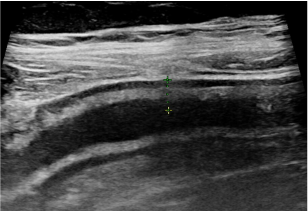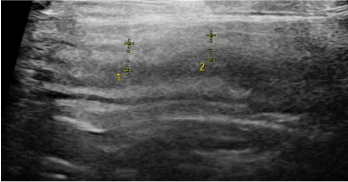This case study highlights the use of intestinal ultrasound in the monitoring and management of acute severe ulcerative colitis.
By: Phillip Gu, MD, Assistant Professor of Medicine, F. Widjaja Intititute, Cedars-Sinai Medical Center, Los Angeles
Case Presentation
A 21 year old female with a history of pan-ulcerati previously on infliximab (secondary loss of response) and Ustekinumab (secondary loss of response) currently on Upadacitinib 30mg who is admitted for acute severe ulcerative colitis after lapse in Upadacitinib due to insurance coverage. Admission CRP was 32.4mg/L and albumin was 3.2g/dL. She was started on IV steroids and Upadacitinib 45mg re-induction immediately. This case illustrates how IUS can be used to monitor response to therapy and help clinical decision making when symptoms and biochemical markers conflict.
Ultrasound Findings
All images show the sigmoid colon. On day 1, the bowel wall thickness was 4.6mm with moderate vascularization. On day 2, bowel wall thickness had improved to 3.3mm with mild vascularization, which correlated with symptomatic and CRP improvement. However, on day 4, her CRP increased from 16.5mg/L to 41mg/L, but she remained symptomatically improved. Day 4 IUS with bowel wall thickness 3.1 and no vascularization, which is still improved from baseline. On Day 5 and 6, CRP continued to rise but symptoms were stable. Day 5 IUS showed new disruption in bowel wall echostratification with stable bowel wall thickness. On Day 6, the bowel wall was completed "blurred out". The following day she has significant worsening symptoms, and decision was made to pursue colectomy given IUS findings that corresponded clinical deterioration.




Clinical Course & Management
While the patient initially demonstrated response to re-induction with Upadacitinib 45mg, her CRP reached its lowest level on day 3 and started to increase on day 4. However, she was symptomatically doing well with no increased BM frequency or blood. Yet, early changes on IUS were noted, especially with disruptions in the bowel wall echostratification. The disruptions continued to worsen, which correlated with a continued rise in CRP, and, on Day 7, her symptoms finally corresponded with other markers suggesting clinical deterioration. Through shared decision making and trending IUS, we were able to engage in effective shared decision making, and we decided to pursue surgery on Day 7. The Patient and her mom stated that seeing her IUS everyday helped their decision making.
Teaching Points
- IUS is a promising adjunct tool for monitoring response to therapy in ASUC.
- IUS findings may not correlate with symptoms and may precede symptoms
- Bowel wall thickness alone may not entirely capture clinical status in ASUC.
- IUS is a powerful tool to support shared decision making in ASUC.

